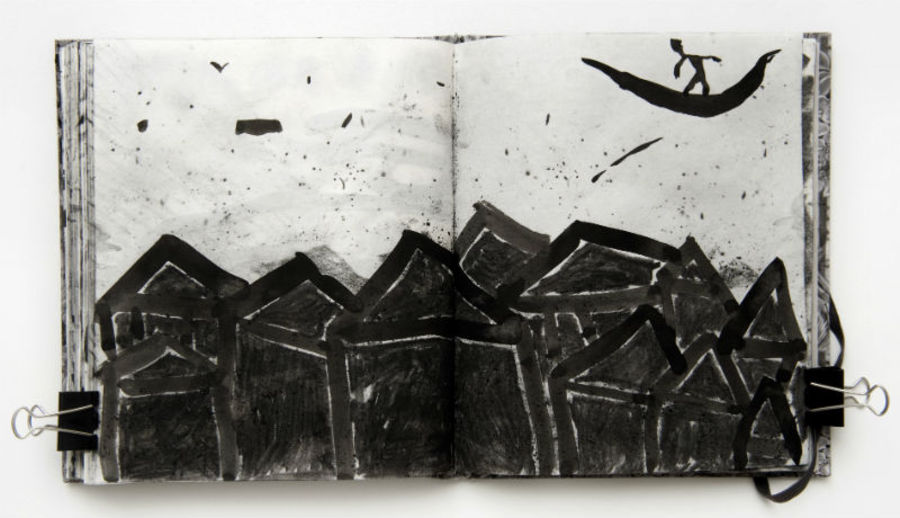Exhibitions
Index / Activities / Exhibitions / Dark is the Tone of My History
Dark is the Tone of My History
From December 13, 2018 until March 03, 2019Mondays through Saturdays, from 11:00 a.m. to 7:30 p.m. Sundays and holidays from 11:00 a.m. to 3:00 p.m.
MADRID
Casa Árabe exhibition halls (at c/ Alcalá, 62).
Mondays through Saturdays, from 11:00 a.m. to 7:30 p.m. Sundays and holidays from 11:00 a.m. to 3:00 p.m.
Free entrance.
From December 13, Casa Árabe is hosting this exhibition by the Iraqi artist Sadik Kwaish Alfraji, curated by Mayssa Fattouh.
Not interrogating the dominance of black in the oeuvre of Sadik Kwaish Alfraji, is missing a large part of the artist’s story and work premise. After graduating as a young man in 1982 from the Institute of Fine Arts in Baghdad under the legacy of Jawad Selim - one of the founders of the Baghdad Modern Art Group in 1951 – Alfraji moved away from the rich color palettes seen in paintings by his predecessors of the early 20th century, and recognized his appreciation for monochromatic tones. According to Alfraji “ black most intensifies the power of expression and is the most contradictory and contrasting of colors”.
Bringing these two bodies of work together serves to showcase the linearity of Alfaji’s forms and topic of the human condition in a disjunctive chronology that reminds us that human nature is deeply rooted in pluralism that spans from the fierce predator to a being of love and hope.
Mayssa Fattouh is a cultural practitioner interested in intersections of art and knowledge production as means of sharing, communicating and hosting work by artists on various themes: broken systems, environmental crisis, motherhood, and other topics that co-constitute human existence.
In Cromophobia, David Batchelor writes that “ Color is perhaps just a loss of identity” and when searching for the Latin colorem, celare, the verbs to hide or conceal, appear as the closest relatives. In Alfraji’s work the predilection of black is not only a search of purity in aesthetics, it is telling the story of his lived history in Iraq. Yearning to expose the sentiment of horror from war atrocities and mourning in its purest forms, avoiding the artifice of color became a tool for the artist as a necessity to intellectualize the tragedy rather than sensualizing it. Inspired by the bold gestural marks of German Expressionism and the monochromatic black and white hues Alfraji employs this visual language to express destructive events as done for example in Picasso’s most powerful political statement Guernica, in 1937.
Having exiled to Europe in 1996, Alfraji was wary of partaking in the Western jubilation before imported ruins to its museums - a phenomena that is described as an “increasing fascination of the 21st century digital age” by Svetlana Boym in her essay Ruinapholia:Appreciation of Ruins as well as the excitement for 3D reconstruction of archaeological sites such as of Iraq, Syria or Afghanistan. But no admiration emanates from the sight of fresh ruins for the direct survivors. In that sense seldom objects are represented by the artist considering material memory as secondary to his existential concerns.
Outside the national or cultural specificities, the massive solitary black bodies central in Alfraji’s paintings and animations epitomize the universal fate of those suffering the loss of loved ones, culture, identity or a birthplace. Alfraji’s approach is a frontal non frivolous one, the individual is the subject and he remains loyal to it throughout his oeuvre. Although his figures haul the weight they are not devoid of hope. Ali’s Boat (2014-2015) triggered by his 11-year-old nephews letter wishing to reunite in the Netherlands in the artist’s new hometown is a deed towards the possibility of the pursuit of happiness and dreams. In I am the Hunter I am the Prey (2017) Alfraji draws on the dialectic relationship between hunter and prey and their inherent trapped existence, taking the form of miniature visual indexing of key figures from Assyrian and Mesopotamian culture and various other manuscripts.
Mayssa Fattouh, curator
Mayssa Fattouh is a cultural practitioner interested in intersections of art and knowledge production as means of sharing, communicating and hosting work by artists on various themes: broken systems, environmental crisis, motherhood, and other topics that co-constitute human existence.
Sadik Kwaish Alfraji (1960, Baghdad) is a leading contemporary artist from Iraq’s diaspora living in Amersfoort, The Netherlands. He received a Bachelor of Fine Art in Painting and Plastic Art from the Academy of Fine Arts, Baghdad in 1987 and a High Diploma in Graphic Design from CHK Constantijn Huygens, Netherlands in 2000. Trained as a painter and printmaker, he also creates animations and artist books. Alfraji has exhibited his work internationally and his work is part of public and private collections including the British Museum, Mathaf: Arab Museum of Modern Art, Los Angeles County Museum of Art, The Museum of Fine Arts Houston and the Barjeel Art Foundation. Alfraji was commissioned to produce a new work for ‘Archaic’ the Iraq Pavilion at the 57th Venice Biennale.

